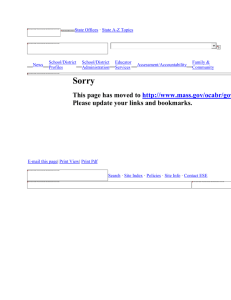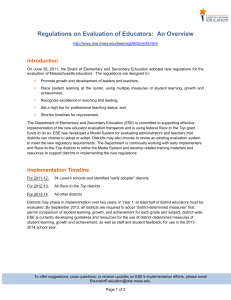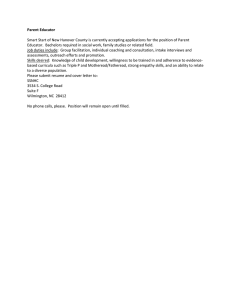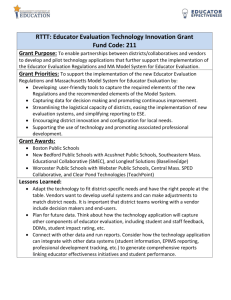2013 03
advertisement
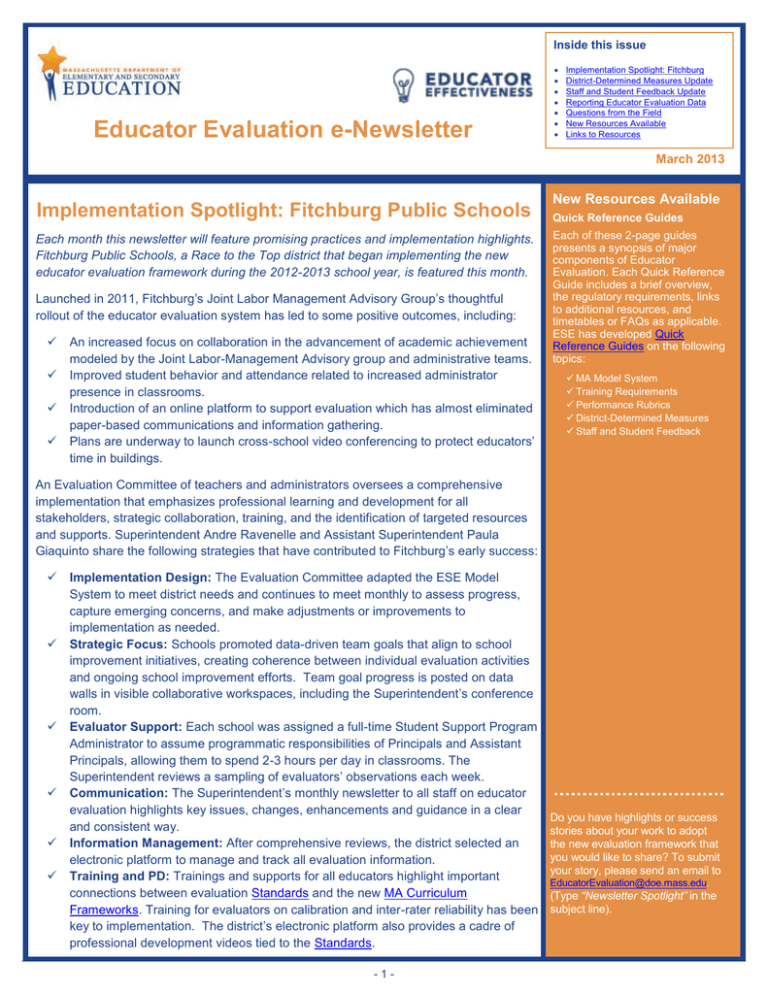
Inside this issue Educator Evaluation e-Newsletter Implementation Spotlight: Fitchburg District-Determined Measures Update Staff and Student Feedback Update Reporting Educator Evaluation Data Questions from the Field New Resources Available Links to Resources March 2013 Implementation Spotlight: Fitchburg Public Schools Each month this newsletter will feature promising practices and implementation highlights. Fitchburg Public Schools, a Race to the Top district that began implementing the new educator evaluation framework during the 2012-2013 school year, is featured this month. Launched in 2011, Fitchburg’s Joint Labor Management Advisory Group’s thoughtful rollout of the educator evaluation system has led to some positive outcomes, including: An increased focus on collaboration in the advancement of academic achievement modeled by the Joint Labor-Management Advisory group and administrative teams. Improved student behavior and attendance related to increased administrator presence in classrooms. Introduction of an online platform to support evaluation which has almost eliminated paper-based communications and information gathering. Plans are underway to launch cross-school video conferencing to protect educators’ time in buildings. New Resources Available Quick Reference Guides Each of these 2-page guides presents a synopsis of major components of Educator Evaluation. Each Quick Reference Guide includes a brief overview, the regulatory requirements, links to additional resources, and timetables or FAQs as applicable. ESE has developed Quick Reference Guides on the following topics: MA Model System Training Requirements Performance Rubrics District-Determined Measures Staff and Student Feedback An Evaluation Committee of teachers and administrators oversees a comprehensive implementation that emphasizes professional learning and development for all stakeholders, strategic collaboration, training, and the identification of targeted resources and supports. Superintendent Andre Ravenelle and Assistant Superintendent Paula Giaquinto share the following strategies that have contributed to Fitchburg’s early success: Implementation Design: The Evaluation Committee adapted the ESE Model System to meet district needs and continues to meet monthly to assess progress, capture emerging concerns, and make adjustments or improvements to implementation as needed. Strategic Focus: Schools promoted data-driven team goals that align to school improvement initiatives, creating coherence between individual evaluation activities and ongoing school improvement efforts. Team goal progress is posted on data walls in visible collaborative workspaces, including the Superintendent’s conference room. Evaluator Support: Each school was assigned a full-time Student Support Program Administrator to assume programmatic responsibilities of Principals and Assistant Principals, allowing them to spend 2-3 hours per day in classrooms. The Superintendent reviews a sampling of evaluators’ observations each week. Communication: The Superintendent’s monthly newsletter to all staff on educator evaluation highlights key issues, changes, enhancements and guidance in a clear and consistent way. Information Management: After comprehensive reviews, the district selected an electronic platform to manage and track all evaluation information. Training and PD: Trainings and supports for all educators highlight important connections between evaluation Standards and the new MA Curriculum Frameworks. Training for evaluators on calibration and inter-rater reliability has been key to implementation. The district’s electronic platform also provides a cadre of professional development videos tied to the Standards. -1- Do you have highlights or success stories about your work to adopt the new evaluation framework that you would like to share? To submit your story, please send an email to EducatorEvaluation@doe.mass.edu. (Type “Newsletter Spotlight” in the subject line). District-Determined Measures Update District-Determined Measures implementation will begin in every district in the 20132014 school year. District-Determined Measures (DDMs) are measures of student learning, growth, and achievement that are comparable across grade or subject level district-wide. DDMs will give Massachusetts’ educators a groundbreaking opportunity to broaden the scope of what student knowledge and skills they assess, improve how they assess learning and gain a better understanding of overall student knowledge and learning patterns. These high-quality, targeted assessments should lead to opportunities for more robust conversations about student learning. Districts should be actively engaged in the process of selecting or developing DDMs for each grade and subject area (603 CMR 35.02) to begin implementation in the 2013-2014 school year. The following suggested steps will help districts position themselves for success: Identify a team of administrators, teachers, and specialists to plan the district’s work on DDMs. Complete an inventory of existing assessments used in the district’s schools. Assess strengths to build on and gaps to fill. Create (or augment) the district’s communication plan to ensure that all stakeholders understand the role of DDMs in the new evaluation framework as well as their timetable for implementation. ESE will be rolling out a suite of comprehensive resources on DDMs to assist districts in this work. ESE will host an 8-part webinar series designed to help district teams prepare for the implementation of DDMs. Webinars will be archived and posted online for those not able to participate. In April 2013, ESE will release the first of two technical guides, focusing on the identification and selection of growth measures. ESE is also seeking a vendor to assist in the collection and evaluation of potential DDMs. The targeted publication date for these DDM exemplars is July 2013. For more information on DDMs and district planning, please review the Quick Reference Guide on District-Determined Measures and Part VII of the Model System: Rating Educator Impact on Student Learning Using District-Determined Measures of Student Learning. Staff and Student Feedback Update In 2013-2014, student feedback will be a required source of evidence in evaluating educator performance and staff feedback will be a required source of evidence for administrator evaluations. In July 2013, ESE will release model surveys for students and staff that will be closely aligned to the Standards and Indicators of Effective Teaching and Effective Administrative Leadership Practice, making it possible for educators and evaluators to use survey results to make meaningful adjustments to classroom instruction and school and district leadership. ESE has worked with national experts, the American Institutes for Research and Cambridge Education, in the development of these surveys. In support of survey administration, ESE is developing an online survey platform in partnership with Panorama Education, which will be available for use beginning in 2013-2014. This survey platform will be free of cost to districts during the first year of implementation and can also be used by districts to implement customized surveys for educator evaluation. For more information, check out the new Quick Reference Guide on Staff and Student Feedback. Please contact us with questions and comments at EducatorEvaluation@doe.mass.edu Reporting Educator Evaluation Data to ESE As districts implement the new Educator Evaluation framework, the regulations require them to annually report individual Educator Evaluation data to ESE (603 CMR 35.11 (5), including formative evaluation ratings for educators on 2-year evaluation cycles. Race to the Top districts should be prepared to report ratings for all educators who are evaluated during the 2012-13 school year (districts were expected to evaluate a minimum of 50 percent of their educators per the regulations (603 CMR 35.11 (1)d)). RTTT districts will submit educator evaluation data through the June 2013 Education Personnel Information Management System (EPIMS) data collection. Thus, RTTT districts will report the following six data elements for any educators who were evaluated: An overall summative performance rating (1 data element) A rating on each of Standards I-IV (4 data elements) An educator’s Professional Teacher Status (where applicable) (1 data element) ESE will also be scheduling information sessions and releasing additional guidance. For more information about reporting the data in EPIMS, please visit the EPIMS website. -2- Links to Resources • MA Educator Evaluation Model System • Educator Evaluation Training Programs • Educator Evaluation Approved Training Vendors for RTTT Districts • Educator Evaluation FAQs • MA Regulations on Educator Evaluation (603 CMR 35.00) • MA Legislation for Implementing Educator Evaluation Questions from the Field 1. Is Educator Evaluation all about MCAS? No. Massachusetts’ evaluation framework is designed to result in a comprehensive portrait of educator practice by incorporating multiple types of evidence across many performance areas. Evidence includes products of educator practice (e.g., artifacts and observations), multiple measures of student learning, growth, and achievement, and other evidence related to the Standards of Effective Practice including feedback from students (and staff in the case of administrators). MCAS Student Growth Percentiles (SGP) will be a source of evidence in the evaluation of some educators (MCAS SGP data can only be directly linked to less than 20 percent of teachers statewide). MCAS will never be the sole source of evidence in an evaluation. Research has demonstrated that this specific combination of measures (observations, multiple measures of student outcomes, and student and staff feedback) yields the most valid and reliable indicator of educator effectiveness. (“Gathering Feedback for Teaching: Combining High-Quality Observations with Student Surveys and Achievement Gains,” The Bill and Melinda Gates Foundation, 2012). 2. Do educators need to be evaluated on all four Standards in the first year of implementation? Yes. Educators need to be evaluated on all four Standards in the first year of implementation. Districts and/or schools may emphasize the importance of certain Standards or Indicators in accordance with local priorities and goals, but all educators are required to be evaluated on each of the four Standards. At the conclusion of any educator’s evaluation cycle, the evaluator must determine a rating on each of the four Standards as well as the overall summative performance rating. 3. Do educators or districts need to submit educator evaluation evidence to ESE? No. ESE does not collect any evidence (such as artifacts of practice or notes from observations) from individual educators or districts. It is up to individual districts to determine how evidence of educator practice will be collected and retained. Questions or Comments are always welcome at EducatorEvaluation@doe.mass.edu Contact the Educator Evaluation Team Claire Abbott, Evaluation Training Program, Implementation Support Kathryn Gabriele, Staff & Student Feedback, District-Determined Measures Kat Johnston, Communications, Peer Assistance & Review, Implementation Support Simone Lynch, Assistant Director, Office of Educator Policy, Preparation and Leadership Ron Noble, Project Co-Lead, Evaluation System Reviews, District-Determined Measures, Staff & Student Feedback Samantha Warburton, Project Co-Lead, MA Model System, Evaluation Training Program & Vendors, Implementation Support The Department of Elementary and Secondary Education is committed to preparing all students for success in the world that awaits them after high school. Whether you are a student, parent, educator, community leader, taxpayer, or other stakeholder interested in education, we invite you to join us in this endeavor. We are guided by this mission... "To strengthen the Commonwealth's public education system so that every student is prepared to succeed in postsecondary education, compete in the global economy, and understand the rights and responsibilities of American citizens, and in so doing, to close all proficiency gaps." And by these goals... Strengthen curriculum, instruction, and assessment Improve educator effectiveness Turn around the lowest performing districts and schools Use data and technology to support student performance To receive the monthly Educator Evaluation e-Newsletter in your inbox, please subscribe at http://edeval-newsletter-signup.org. -3-

